Investigating the Cycling Stability of Fe2WO6 Pseudocapacitive Electrode Materials
Abstract
1. Introduction
2. Materials and Methods
2.1. Polyol-Mediated Synthesis
2.2. Electrode Preparation
2.3. Characterization of the Material and Electrodes
3. Results and Discussion
3.1. Synthesis and Structural Characterization
3.2. Electrochemical Characterization
3.3. Long Cycling Stability Study
3.3.1. Surface Observation by Transmission Electron Microscopy
3.3.2. Mössbauer Spectroscopy Analysis
3.3.3. Magnetization Measurements on FWO-600 Electrodes
4. Conclusions
Supplementary Materials
Author Contributions
Funding
Institutional Review Board Statement
Informed Consent Statement
Acknowledgments
Conflicts of Interest
References
- Conway, B.E. Electrochemical Supercapacitors: Scientific Fundamentals and Technological Applications; Springer: New York, NY, USA, 1999; ISBN 978-1-4757-3060-9. [Google Scholar]
- Beguin, F.; Frackowiak, E. Supercapacitors: Materials, Systems, and Applications; John Wiley & Sons, Inc.: Hoboken, NJ, USA, 2013; ISBN 978-3-527-32883-3. [Google Scholar]
- Simon, P.; Brousse, T.; Favier, F. Supercapacitors Based on Carbon or Pseudocapacitive Materials; John Wiley & Sons, Inc.: Hoboken, NJ, USA, 2017; ISBN 978-1-119-00733-3. [Google Scholar]
- Simon, P.; Burke, A. Nanostructured Carbons: Double-Layer Capacitance and More. Electrochem. Soc. Interface 2008, 17, 38–43. [Google Scholar] [CrossRef]
- Simon, P.; Gogotsi, Y. Materials for Electrochemical Capacitors. Nat. Mater. 2008, 7, 845–854. [Google Scholar] [CrossRef]
- Simon, P.; Gogotsi, Y. Perspectives for Electrochemical Capacitors and Related Devices. Nat. Mater. 2020, 19, 1151–1163. [Google Scholar] [CrossRef] [PubMed]
- Brousse, T.; Bélanger, D.; Chiba, K.; Egashira, M.; Favier, F.; Long, J.; Miller, J.R.; Morita, M.; Naoi, K.; Simon, P.; et al. Materials for Electrochemical Capacitors. In Springer Handbook of Electrochemical Energy; Breitkopf, C., Swider-Lyons, K., Eds.; Springer: Berlin/Heidelberg, Germany, 2017; pp. 495–561. ISBN 978-3-662-46657-5. [Google Scholar]
- Brousse, T.; Crosnier, O.; Bélanger, D.; Long, J.W. 1—Capacitive and Pseudocapacitive Electrodes for Electrochemical Capacitors and Hybrid Devices. In Metal Oxides in Supercapacitors; Dubal, D.P., Gomez-Romero, P., Eds.; Metal Oxides; Elsevier: Amsterdam, The Netherlands, 2017; pp. 1–24. ISBN 978-0-12-811169-7. [Google Scholar]
- Trasatti, S.; Buzzanca, G. Ruthenium Dioxide: A New Interesting Electrode Material. Solid State Structure and Electrochemical Behaviour. J. Electroanal. Chem. Interfacial Electrochem. 1971, 29, A1–A5. [Google Scholar] [CrossRef]
- Lee, H.Y.; Goodenough, J.B. Supercapacitor Behavior with KCl Electrolyte. J. Solid State Chem. 1999, 144, 220–223. [Google Scholar] [CrossRef]
- Toupin, M.; Brousse, T.; Bélanger, D. Influence of Microstucture on the Charge Storage Properties of Chemically Synthesized Manganese Dioxide. Chem. Mater. 2002, 14, 3946–3952. [Google Scholar] [CrossRef]
- Wu, N.-L. Nanocrystalline Oxide Supercapacitors. Mater. Chem. Phys. 2002, 75, 6–11. [Google Scholar] [CrossRef]
- Crosnier, O.; Goubard-Bretesché, N.; Buvat, G.; Athouël, L.; Douard, C.; Lannelongue, P.; Favier, F.; Brousse, T. Polycationic Oxides as Potential Electrode Materials for Aqueous-Based Electrochemical Capacitors. Curr. Opin. Electrochem. 2018, 9, 87–94. [Google Scholar] [CrossRef]
- Goubard-Bretesché, N.; Crosnier, O.; Payen, C.; Favier, F.; Brousse, T. Nanocrystalline FeWO4 as a Pseudocapacitive Electrode Material for High Volumetric Energy Density Supercapacitors Operated in an Aqueous Electrolyte. Electrochem. Commun. 2015, 57, 61–64. [Google Scholar] [CrossRef]
- Goubard-Bretesché, N.; Crosnier, O.; Buvat, G.; Favier, F.; Brousse, T. Electrochemical Study of Aqueous Asymmetric FeWO 4 /MnO 2 Supercapacitor. J. Power Sources 2016, 326, 695–701. [Google Scholar] [CrossRef]
- Goubard-Bretesché, N.; Crosnier, O.; Douard, C.; Iadecola, A.; Retoux, R.; Payen, C.; Doublet, M.; Kisu, K.; Iwama, E.; Naoi, K.; et al. Unveiling Pseudocapacitive Charge Storage Behavior in FeWO4 Electrode Material by Operando X-Ray Absorption Spectroscopy. Small 2020, 16, 2002855. [Google Scholar] [CrossRef]
- Pinto, H.; Melamud, M.; Shaked, H. Magnetic Structure of Fe2WO6, a Neutron Diffraction Study. Acta Crystallogr. Sect. A 1977, 33, 663–667. [Google Scholar] [CrossRef]
- Guskos, N.; Sadlowski, L.; Typek, J.; Likodimos, V.; Gamari-Seale, H.; Bojanowski, B.; Wabia, M.; Walczak, J.; Rychlowska-Himmel, I. Magnetic and EPR Studies of α-, β-, and γ-Fe2WO6 Phases at Low Temperatures. J. Solid State Chem. 1995, 120, 216–222. [Google Scholar] [CrossRef]
- Kendrick, E.; Świątek, A.; Barker, J. Synthesis and Characterisation of Iron Tungstate Anode Materials. J. Power Sources 2009, 189, 611–615. [Google Scholar] [CrossRef]
- Rawal, S.B.; Ojha, D.P.; Sung, S.D.; Lee, W.I. Fe2WO6/TiO2, an Efficient Visible-Light Photocatalyst Driven by Hole-Transport Mechanism. Catal. Commun. 2014, 56, 55–59. [Google Scholar] [CrossRef]
- Abdi, F.F.; Chemseddine, A.; Berglund, S.P.; van de Krol, R. Assessing the Suitability of Iron Tungstate (Fe2WO6) as a Photoelectrode Material for Water Oxidation. J. Phys. Chem. C 2017, 121, 153–160. [Google Scholar] [CrossRef]
- Ungelenk, J.; Speldrich, M.; Dronskowski, R.; Feldmann, C. Polyol-Mediated Low-Temperature Synthesis of Crystalline Tungstate Nanoparticles MWO4 (M = Mn, Fe, Co, Ni, Cu, Zn). Solid State Sci. 2014, 31, 62–69. [Google Scholar] [CrossRef]
- Dong, H.; Chen, Y.-C.; Feldmann, C. Polyol Synthesis of Nanoparticles: Status and Options Regarding Metals, Oxides, Chalcogenides, and Non-Metal Elements. Green Chem. 2015, 17, 4107–4132. [Google Scholar] [CrossRef]
- Brousse, T.; Taberna, P.-L.; Crosnier, O.; Dugas, R.; Guillemet, P.; Scudeller, Y.; Zhou, Y.; Favier, F.; Bélanger, D.; Simon, P. Long-Term Cycling Behavior of Asymmetric Activated Carbon/MnO2 Aqueous Electrochemical Supercapacitor. J. Power Sources 2007, 173, 633–641. [Google Scholar] [CrossRef]
- Gogotsi, Y.; Simon, P. True Performance Metrics in Electrochemical Energy Storage. Science 2011, 334, 917–918. [Google Scholar] [CrossRef]
- Grosse, G. PC-Mos II, Version 1.0 Manual and Program Documentation; FASTComTec: Oberhaching, Germany, 1993. [Google Scholar]
- Petříček, V.; Dušek, M.; Palatinus, L. Crystallographic Computing System JANA2006: General Features. Z. Krist. Cryst. Mater. 2014, 229, 345–352. [Google Scholar] [CrossRef]
- Augustyn, V.; Simon, P.; Dunn, B. Pseudocapacitive Oxide Materials for High-Rate Electrochemical Energy Storage. Energy Environ. Sci. 2014, 7, 1597. [Google Scholar] [CrossRef]
- Brousse, T.; Bélanger, D.; Long, J.W. To Be or Not to Be Pseudocapacitive? J. Electrochem. Soc. 2015, 162, A5185–A5189. [Google Scholar] [CrossRef]
- Ghodbane, O.; Ataherian, F.; Wu, N.-L.; Favier, F. In situ Crystallographic Investigations of Charge Storage Mechanisms in MnO2-Based Electrochemical Capacitors. J. Power Sources 2012, 206, 454–462. [Google Scholar] [CrossRef]
- Hsieh, Y.-C.; Lee, K.-T.; Lin, Y.-P.; Wu, N.-L.; Donne, S.W. Investigation on Capacity Fading of Aqueous MnO2·nH2O Electrochemical Capacitor. J. Power Sources 2008, 177, 660–664. [Google Scholar] [CrossRef]
- Ataherian, F.; Wu, N.-L. Long-Term Charge/Discharge Cycling Stability of MnO2 Aqueous Supercapacitor under Positive Polarization. J. Electrochem. Soc. 2011, 158, A422. [Google Scholar] [CrossRef]
- Birchall, T.; Hallett, C.; Vaillancourt, A.; Ruebenbauer, K. A Study of Iron–Tungsten Oxides and Iron–Chromium–Tungsten Oxides. Can. J. Chem. 1988, 66, 698–702. [Google Scholar] [CrossRef]
- Greenwood, N.N.; Gibb, T.C. Mössbauer Spectroscopy. J. Mol. Struct. 1972, 13, 138–139. [Google Scholar] [CrossRef]
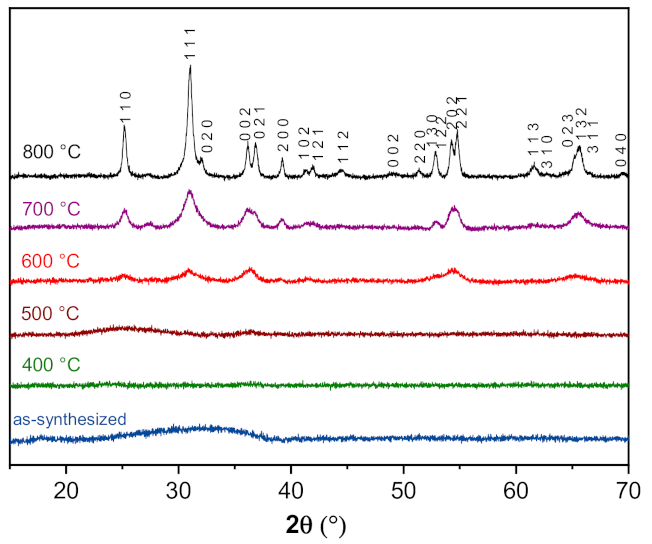
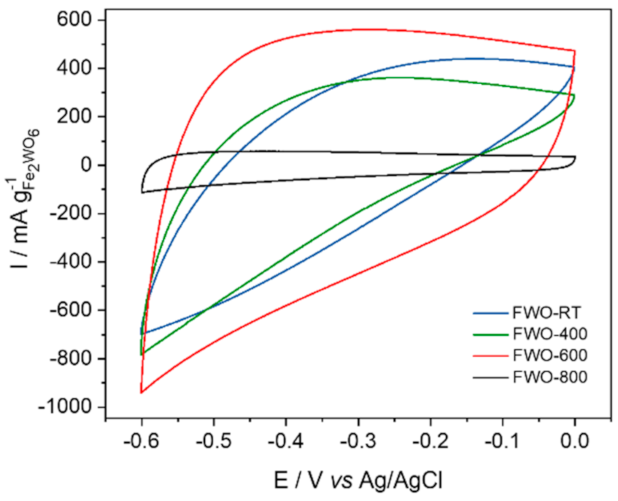
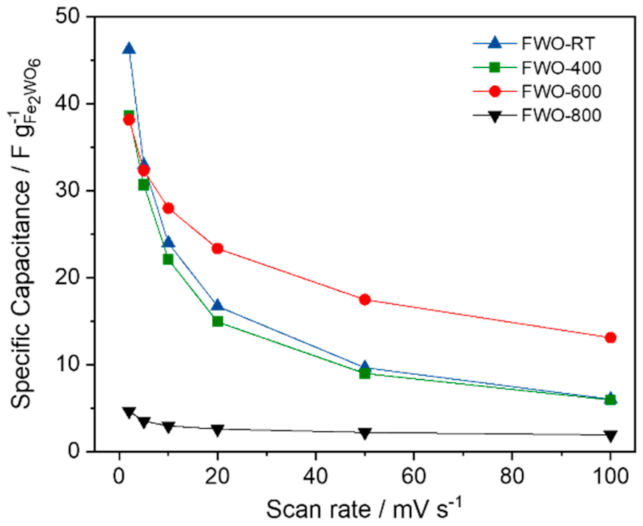
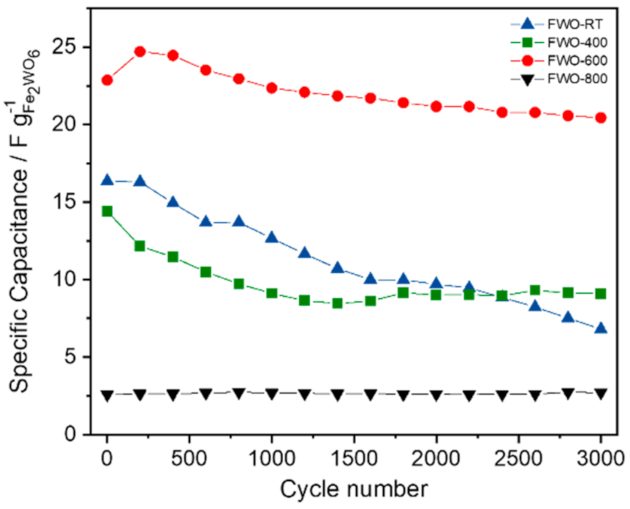
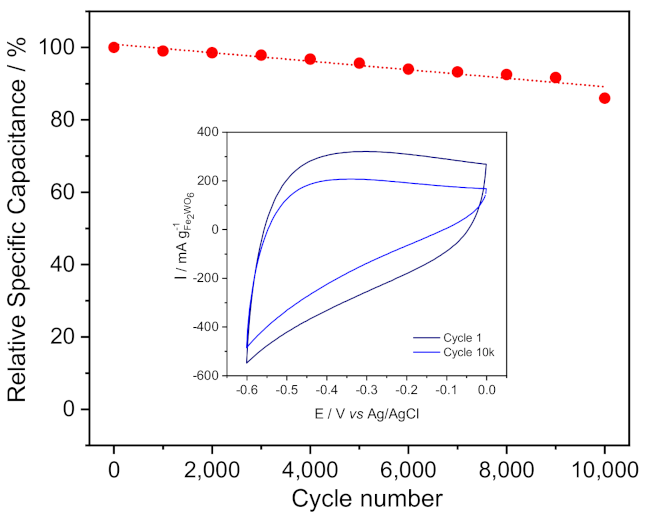
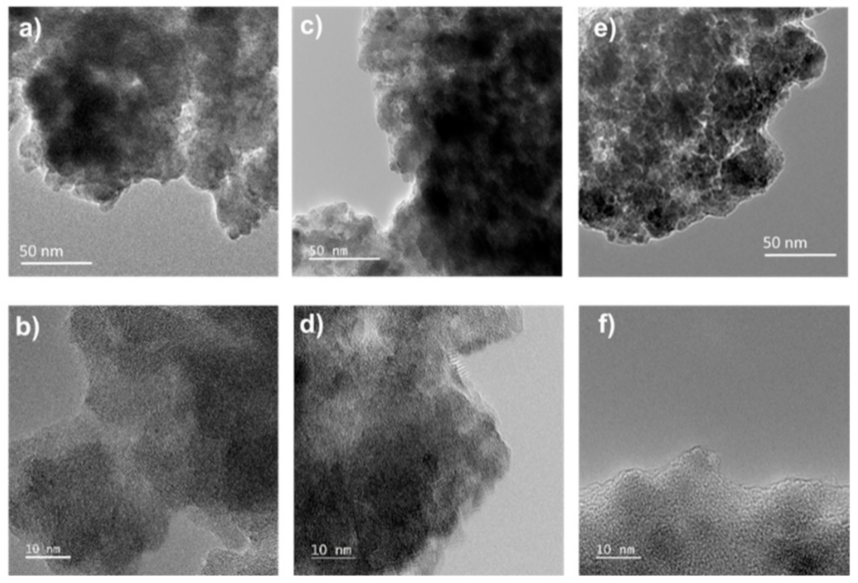
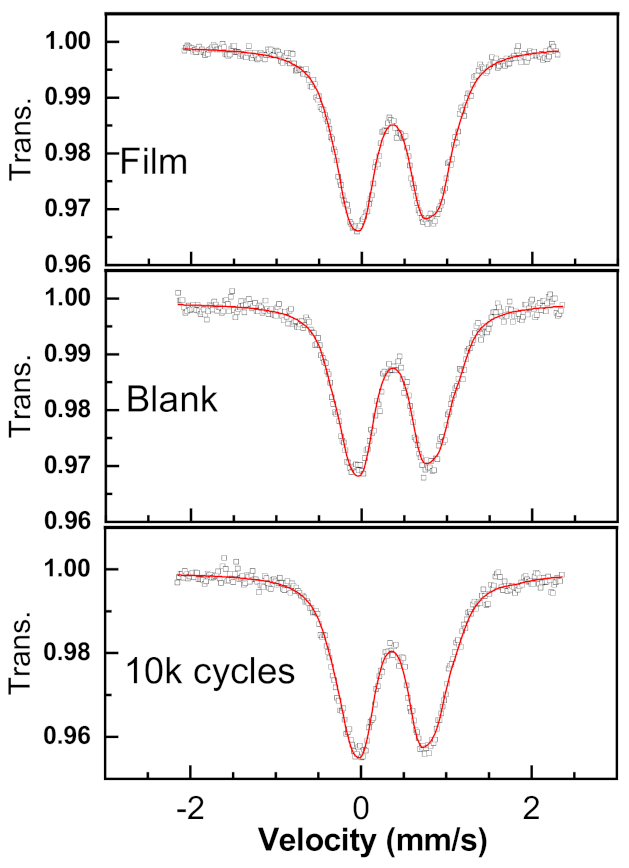
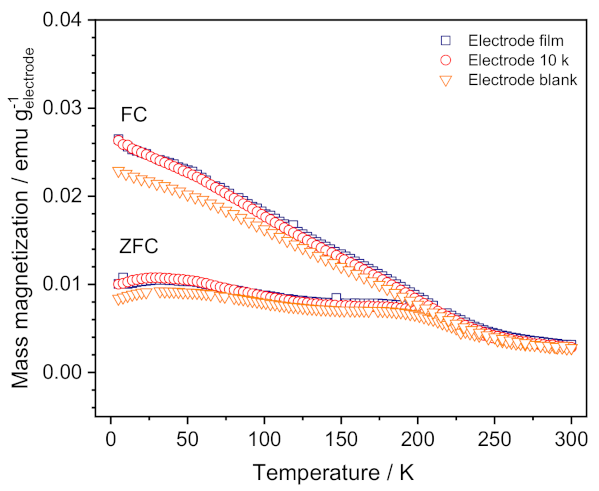
| Sample | <IS> (mm/s) | <QS> (mm/s) | <LW> (mm/s) |
|---|---|---|---|
| Film | 0.37 | 0.85 | 0.38 |
| Blank | 0.39 | 0.84 | 0.35 |
| 10k cycles | 0.40 | 0.79 | 0.36 |
Publisher’s Note: MDPI stays neutral with regard to jurisdictional claims in published maps and institutional affiliations. |
© 2021 by the authors. Licensee MDPI, Basel, Switzerland. This article is an open access article distributed under the terms and conditions of the Creative Commons Attribution (CC BY) license (https://creativecommons.org/licenses/by/4.0/).
Share and Cite
Espinosa-Angeles, J.C.; Goubard-Bretesché, N.; Quarez, E.; Payen, C.; Sougrati, M.-T.; Crosnier, O.; Brousse, T. Investigating the Cycling Stability of Fe2WO6 Pseudocapacitive Electrode Materials. Nanomaterials 2021, 11, 1405. https://doi.org/10.3390/nano11061405
Espinosa-Angeles JC, Goubard-Bretesché N, Quarez E, Payen C, Sougrati M-T, Crosnier O, Brousse T. Investigating the Cycling Stability of Fe2WO6 Pseudocapacitive Electrode Materials. Nanomaterials. 2021; 11(6):1405. https://doi.org/10.3390/nano11061405
Chicago/Turabian StyleEspinosa-Angeles, Julio César, Nicolas Goubard-Bretesché, Eric Quarez, Christophe Payen, Moulay-Tahar Sougrati, Olivier Crosnier, and Thierry Brousse. 2021. "Investigating the Cycling Stability of Fe2WO6 Pseudocapacitive Electrode Materials" Nanomaterials 11, no. 6: 1405. https://doi.org/10.3390/nano11061405
APA StyleEspinosa-Angeles, J. C., Goubard-Bretesché, N., Quarez, E., Payen, C., Sougrati, M.-T., Crosnier, O., & Brousse, T. (2021). Investigating the Cycling Stability of Fe2WO6 Pseudocapacitive Electrode Materials. Nanomaterials, 11(6), 1405. https://doi.org/10.3390/nano11061405







